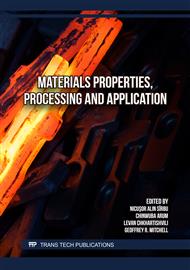[1]
Martina Vigata, Christoph Meinert, Dietmar W. Hutmacher, and Niels Bock. Hydrogels as drug delivery systems: A review of current characterization and evaluation techniques. Pharmaceu- tics, 12(12):1188, 2020.
DOI: 10.3390/pharmaceutics12121188
Google Scholar
[2]
Mayur Jadav, Deepika Pooja, David J. Adams, and Harish Kulhari. Advances in xanthan gum- based systems for the delivery of therapeutic agents. Pharmaceutics, 15(2):402, 2023.
DOI: 10.3390/pharmaceutics15020402
Google Scholar
[3]
Eneko Larrañeta, Sarah A. Stewart, Michael Ervine, Rehan Al-Kasasbeh, and Ryan F. Donnelly. Hydrogels for hydrophobic drug delivery. classification, synthesis and applications. Journal of Functional Biomaterials, 9, 2018.
DOI: 10.3390/jfb9010013
Google Scholar
[4]
Mohammadmahdi Mobaraki, Davood Bizari, Madjid Soltani, Hadi Khshmohabat, Kaamran Raahemifar, and Mehdi Akbarzade Amirdehi. The effects of curcumin nanoparticles incor- porated into collagen-alginate scaffold on wound healing of skin tissue in trauma patients. Poly- mers, 13, 12 2021.
DOI: 10.3390/polym13244291
Google Scholar
[5]
Bharat B Aggarwal, Subash C Gupta, and Bokyung Sung. Theme section: Emerging therapeutic aspects in oncology curcumin: an orally bioavailable blocker of tnf and other pro-inflammatory biomarkers. Br J Pharmacol, 169, 2013.
DOI: 10.1111/bph.12131
Google Scholar
[6]
Ping Zhou, Hao Zhou, Jian Shu, Shaozhi Fu, and Zhu Yang. Skin wound healing promoted by novel curcumin-loaded micelle hydrogel. Annals of Translational Medicine, 9:1152–1152, 7 2021.
DOI: 10.21037/atm-21-2872
Google Scholar
[7]
Yasir Hussain, Waqas Alam, Haroon Ullah, Maurizio F. Dacrema, Maria Daglia, Haroon Khan, and Carla Renata Arciola. Antimicrobial potential of curcumin: Therapeutic potential and chal- lenges to clinical applications. Antibiotics, 11(3):322, 2022.
DOI: 10.3390/antibiotics11030322
Google Scholar
[8]
Kuen Yong Lee and David J. Mooney. Alginate: Properties and biomedical applications. Progress in Polymer Science, 37(1):106–126, 2012.
DOI: 10.1016/j.progpolymsci.2011.06.003
Google Scholar
[9]
Junyan Tan, Yuning Luo, Yuqiong Guo, Yue Zhou, Xinying Liao, Dingxilei Li, Xinyi Lai, and Yang Liu. Development of alginate-based hydrogels: Crosslinking strategies and biomedical applications. International Journal of Biological Macromolecules, 239:124275, 2023.
DOI: 10.1016/j.ijbiomac.2023.124275
Google Scholar
[10]
Mohamed A.S. Abourehab, Ritesh R. Rajendran, Akanksha Singh, Satya Pramanik, Prashant Shrivastav, Mohd Javed Ansari, Ravi Manne, Luis S. Amaral, and Akshay Deepak. Alginate as a promising biopolymer in drug delivery and wound healing: A review of the state-of-the-art. International Journal of Molecular Sciences, 23(16):9035, 2022.
DOI: 10.3390/ijms23169035
Google Scholar
[11]
Kun Wang, Jie Sui, Wei Gao, Bin Yu, Chao Yuan, Li Guo, Bo Cui, and A.M. Abd El-Aty. Effects of xanthan gum and sodium alginate on gelatinization and gels structure of debranched pea starch by pullulanase. Food Hydrocolloids, 130:107733, 2022.
DOI: 10.1016/j.foodhyd.2022.107733
Google Scholar
[12]
Cinzia Pagano, Debora Puglia, Francesca Luzi, Alessandro Di Michele, Stefania Scuota, Sara Primavilla, Maria Rachele Ceccarini, Tommaso Beccari, César Antonio Viseras Iborra, Daniele Ramella, Maurizio Ricci, and Luana Perioli. Development and characterization of xanthan gum and alginate based bioadhesive film for pycnogenol topical use in wound treatment. Pharma- ceutics, 13(3), 2021.
DOI: 10.3390/pharmaceutics13030324
Google Scholar
[13]
Ramesh C. Garg, Vinod Kumar, and Vandana Sharma. Design and characterization of flucyto- sine loaded bioadhesive in situ ophthalmic gel for improved bioavailability. 2019.
DOI: 10.20510/ukjpb/7/i6/1581754222
Google Scholar
[14]
Prerna Chansoria, Lakshmi K. Narayanan, Molly Wood, Caroline Alvarado, Angela Lin, and Rahul A. Shirwaiker. Effects of autoclaving, etoh, and uv sterilization on the chemical, mechan- ical, printability, and biocompatibility characteristics of alginate. ACS Biomaterials Science & Engineering, 6(9):5191–5201, September 2020. Epub 2020 Jul 31.
DOI: 10.1021/acsbiomaterials.0c00806
Google Scholar
[15]
Yingjun Gao, Xing Zhang, and Xiangyu Jin. Preparation and properties of minocycline-loaded carboxymethyl chitosan gel/alginate nonwovens composite wound dressings. Marine Drugs, 17(10):575, 2019.
DOI: 10.3390/md17100575
Google Scholar
[16]
Sandhuli S. Hettiarachchi, Yohanka Perera, Shashiprabha P. Dunuweera, Asiri N. Dunuweera, Sanath Rajapakse, and Gamini R. Rajapakse. Comparison of antibacterial activity of nanocur- cumin with bulk curcumin. ACS Omega, 7(50):46494–46500, 2022.
DOI: 10.1021/acsomega.2c05293
Google Scholar


